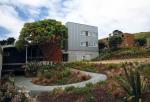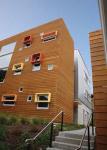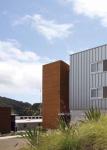Leigh Marine Centre
Since the early 1960s the University of Auckland’s Marine Laboratory at Leigh has played a vital role in marine science research and education. Over the years the centre has grown to accommodate the increasing numbers of academic staff and those doing undergraduate and postgraduate work on the marine campus.
But the success of the programme had also become a bit of a problem as buildings were added or extended on the clifftop site but with no overall plan, says rthur Cozens, the operations manager at the laboratory.
“It’s grown like a Kiwi bach,” he says. “There’s been a bit of this and a bit of that and while the infrastructure worked, it was not all that well thought out.” And things might have remained that way if not for a generous donation of $4.6 million from the Edith Winstone Blackwell Foundation Trust.
The donation kick-started a $10 million redevelopment of the site on a pohutukawa-fringed headland that overlooks the Goat Island Marine Reserve.
The redevelopment, master planned by Cheshire Architects in conjunction with the University’s own Property Services Department, involved the reuse and refurbishment of existing buildings, and the construction of three new buildings: a block of bunkrooms, a science centre and an information centre for the public, which has been named the Edith Winstone Blackwell Interpretive Centre.
Arthur Cozens says the steepness of the site meant buildings that looked good on paper weren’t necessarily going to be practical to build. And because the buildings are on a prominent coastal site, gaining resource consent for the redevelopment was always going to be a challenge with building heights and colours critical factors.
”The fundamental brief was that the buildings had to work and be structured in a manner that would fly the resource consent,” Arthur says.
Sean Flanagan, of Cheshire Architects, says coastal sites such as that at Leigh provide challenges because they are visually sensitive but harsh environments, especially as sea spray is a factor.
“Working in a close relationship with the Property Services Department, we did a lot of research into the materials that we would use,” he says. “And the reflectivity of the buildings was a consideration.”
Because of its robust nature, Colorcote ARX was chosen for the roofing and cladding on the interpretive centre, and was also used to partially clad the science centre which also has timber cladding and exposed blockwork. Colorcote ARX has also been used to roof the timberclad bunkrooms.
The EurostyleTM metal cladding was installed with angle standing seams on the science and interpretive centres to create shadow lines across the elevation. On the interpretive centre, three different tray widths were used and arrayed in a pattern to make the façade shimmer in the light.
The science centre, which sits behind the interpretive centre when seen from the marine reserve, steps up the slope to a maximum height of three stories, minimizing its visual impact “At resource consent stage we had to show how the buildings sat from the sea,” says Sean. “Siting the buildings within the clifftop fringe of pohutkawas helps the buildings settle into this sensitive site.” The Edith Winstone Blackwell Interpretive Centre was given a jagged edge on its public face to draw people to it.
“We paid a lot of attention to the form of the interpretive centre building,” says Sean. “Pip [Cheshire] said it had to ‘shake its hips’ a bit, to attract the public parking down the hill and draw them into walking up to the centre. The gill-like serrated edge down one side gives it some presence but it also gives you views into the building as you walk up the hill.” Sean says a lot of work went into the detailing of the roofing and cladding to add interest to the building.
“The seams on the interpretive centre are quite subtle – on the science centre they are regular but on the interpretive centre we have used different EurostyleTM tray widths to enrich the façade,” he says. “We also put a lot of effort into making it look like the wall folded over the roof, again to give it some interest but at the same time that detail has to work in terms of weathertightness.”
Whereas the interpretive centre is metal, the bunkrooms are timber construction, with the science centre providing a link between the two. “The science centre is timber and metal so it’s the hinge building,” says Sean. “- we created a conversation between the three buildings.” The bunkroom was the first of the three buildings completed and the timber cladding has been designed to weather and settle into its surroundings. “The bunkroom has stained radiata pine rain screen boards but in behind is a shadowclad plywood system,” says Sean. “It’s like the building has a raincoat to deflect the harsh coastal weather, but the coat will also protect it from the sun.”
The science centre was the next to be constructed and has laboratories, student spaces and academic offices. It has been designed so that marine samples can be brought into the building straight from the research boats, sorted and cleaned before being moved through to the spotless microscopy room. The recently completed interpretive centre will give the public a window into the sort of research done at the marine centre. An entry fee is charged to the centre, which has video screens, touch screens, display boards and specimens on show.
”The centre has to meet its own costs but it also has to be accessible and allow the public to see our marine environment and highlight the work of the people in the science building,” says Arthur Cozens. “It also supplies some income for graduate students who show the public what we actually do,
why we do it and why it is important.
”We are making no bones about the fact that we also hope it will be a pathway into the university for youngsters, and not just those interested in marine biology.”
Cheshire Architects





